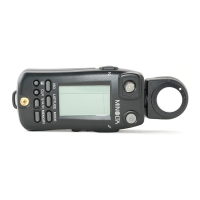Exposure can be measured in two basic ways. One way is to measure the
light incident on the subject, i.e. the brightness of light illuminating the
subject (illuminance) (see Fig. 1); the other is to measure the light Spot
reflected by the subject, i.e. the intensity of the light reflected from the
subject in the direction of the camera (luminance) (see Fig. 2).
Fig. 1 Incident-light method Fig. 2 Spot (Reflected-light) method
Before selecting the most suitable measuring method, you need to fully
understand the different sources of light you are working with, as well as
the influence of the positions and direction of receptors during
measurement.
Incident-light readings
In general photography, light from the illuminating light source reflects off
the subject and passes through the lens to form an image on the film, and
to expose the film.
To accurately calculate exposure in incident-light readings, you need to
know how much of the illuminating light is actually reflected from the object
to the camera. To do this, you need to know how light or how dark the
subject is, i.e. the reflectance of the subject.
Since a typical value of reflectance for many scenes is 18%*, this value is
used to calculate the light intensity reflected from the subject towards the
camera. The exposure reading (f-number and shutter speed) are then
calculated to reproduce the metered area as a midtone with 18%
reflectance.
Preparations
E16
Preparations
E17
Thus, incident-light readings are based on this standard value of 18%
reflectance. This means that areas of subjects having a reflectance higher
than 18% will turn out brighter (e.g. white), while areas of reflectance lower
than 18% will turn out darker (e.g. black). This will produce a clear contrast
in the picture of the subject. From this, we can see that this measuring
method provides for natural tonal range over the entire composition.
* The value of “18%” has been determined to be a typical reflectance value for many
different subjects.
Fig. 3
To make effective incident-light exposure readings, you must use the
Spherical Diffuser and Flat Diffuser creatively.
When photographing three-dimensional objects such as people, the
highlights and shadow areas of a composition depend on the direction of
the main illuminating light source. Exposure is also influenced by any light
reflected towards the camera from the sides or rear of the subject (Fig. 3
(a)). In these situations, the Spherical Diffuser captures the illuminating
light coming from different directions at the position of the subject, so that
the exposure reading takes into account the contribution of this light on
illuminating the subject. On the other hand, with flat subjects such as
pictures and documents, light from the sides or rear of the subject
generally make little or no contribution to illuminating the subject (Fig. 3(b)).
So, for these situations, accurate exposure readings are made using a Flat
Diffuser to capture only the illuminating light from the front of the subject.
Difference between incident-light
and Spot (reflected-light) readings
Incident- light
Light source
Light source
Camera
Reflected-
light
Camera
(a)
(b)
Three-
dimensional
subjects
Flat subjects
flashmetervieng.qx3302.12.259:21PMページ16

